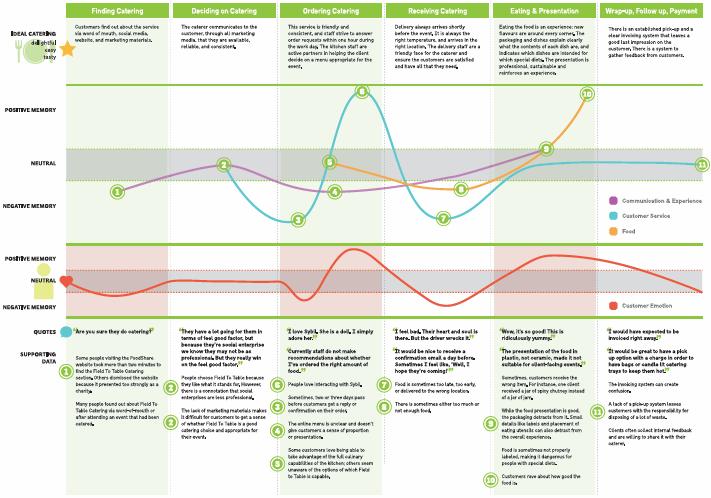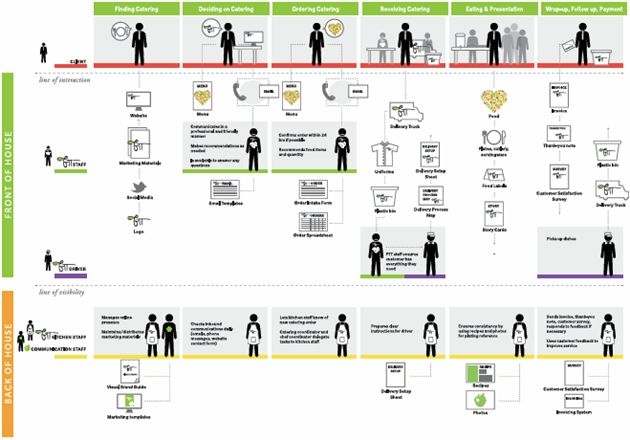Today, marketing professionals are under a ton of pressure to understand and improve customer experience. Brands and marketers alike realize that paying attention to what you say in your ads, marketing collateral, and social media campaigns is no longer enough: You also need to deliver experiences that people want...
But how?
When companies consider design as a core strategic function, they have a much higher valuation over time: Design-driven companies show 10-year returns of 219% over the Standard & Poor's 500 index, the Design Management Institute has found. Yet, although strategic design is being practiced, and successfully at that, at some organizations, many others are baffled by the challenge and struggle to get started.
The typical organization is composed of any number of departments, each charged with its own specific initiative. Often, a department is able to perfect its specific piece of the puzzle—at the expense of a seamless end-to-end customer experience.
For example, a telecom's initiative to reduce call volume might end up reducing the amount of incoming calls... at the expense of driving more people into the store to get help. Or a bank might invest heavily in a new website for opening new accounts, only to realize that people default to going into the branch because they have set-up questions or concerns regarding the security of their personal data.
From my experience, the only way for an organization to avoid such problems and to be successful, is to adopt the mindset of their customers. Or, better yet, to integrate the customer in the design of an optimal customer journey. It's a methodology called co-design.
The Power of Customer-Centric Co-Design
Once you realize that you've been designing your customer experience all wrong by simply following traditional business practices that prioritize efficiency and scale over the satisfaction of the end-user, it's time to set things straight.
But how? Change is notoriously difficult, and asking your entire organization to modify the way they think and work is not going to be met with a resounding "yes!"
However, it is possible... and the following three steps will help you get on your way.
Step 1: Build a framework that's focused on understanding the customer experience—from the customer's point of view
Before people can change their behavior, they need to understand how their current actions are affecting the rest of the business—and, most important, the end-user. The best way to do that is to create an experience map.
The goal of an experience map is to enable your employees to view things through the eyes of the customer, not their particular department or function. Because only the customer sees the complexity of your entire business.
In most organizations, each department is focused on doing a great job. They're all committed to delivering on their plans and meeting their individual KPIs. But do they understand how their role fits into the larger customer journey? Is the work of the billing department aligned with the customer service people receive during set-up as a new customer? Are marketing communications highlighting the information that is most important to the service? Does everyone truly understand the customer's highs and lows?
An experience map can help departments, teams, and individual employees see beyond their own contributions to deliver even greater value. It is a universal tool that cuts across departments' particular terminology, acronyms, and nuances. It provides clarity about where each person fits in the process and helps unite all stakeholders around the actual experience of their customers.
In Figure 1, we show the customer experience highs and lows of a catering business run as a social venture by a national nonprofit. The food was great, but the crux of the service—such as making and changing orders and delivery/setup—was awful. The business needed to understand that no matter the quality or taste of the food, if the ordering and delivery process was miserable, and people ended their experience with less than positive memories, the business wouldn't survive.
Step 2: Create a service blueprint to identify the future state of your customer-centric organization
If the experience map is the current state, the service blueprint is the future state that provides direction on what the customer experience needs to look like once all the right touchpoints are in place. The service blueprint is a "shared artifact" that unites the departments and keeps people aligned on the journey of creating the optimal experience for the end-user.
Let's go back to the catering business: We used a Service Blueprint to show changes along the journey to key customer touchpoints, such as an improved Web portal for placing food orders (see Figure 2, below). The service blueprint would also identify critical "back of house" changes, such as the order management system viewed by employees and the standard operating principles that the team would use for delivery and setup. Contextualizing these new touchpoints within a service blueprint helps teams understand how all of their individual contributions build toward a seamless end-to-end customer experience.
It's important for people to feel a part of the creation of the service blueprint. Authorship creates a sense of ownership: If they are involved in creating it, they will understand why it is happening, the initiatives will be more practical, and they will feel more committed to keeping it alive. And you need everyone invested to succeed.
Step 3: Establish a new set of metrics
Along with the creation of an experience map and service blueprint, you need to set up a new measurement process to help keep everyone accountable. The goal is to look at not just the output of one group in isolation but all the relevant customer data, collectively. So, for example, you might choose to develop a dashboard that pulls together metrics from departments, giving you a comprehensive view of how your organization is performing. Also, it's important to measure as you go. Let real-time tools help you access your progress and make adjustments immediately.
It's one thing to say you're a customer-centric organization, but it's another thing to actually act like one. By staying on top of your metrics, you can make sure that change is really occurring and you can understand where to prioritize efforts down the road.
Stay the Course
It takes time to retune your business and change the way you think about your customer. But an experience map, a service blueprint, co-design, and collaborative ways of working can make it happen. These shared artifacts help connect people together and make working as a cohesive, customer-centric organization the norm.
Your customers are more discerning than ever, and they have an ever-expanding set of options. If your customers have a seamless and delightful experience with a company in a different industry, they're going to expect yours to match or exceed that experience that company provides, whether or not it's a competitor of yours.
The only way to compete to win for the long-term is to sustain your focus on creating the ultimate customer journey—and you need the decision-makers, the frontline workers, and your customers working together to reimagine what your service offering can be in order to win.
More Resources on Becoming a Customer-Centric Organization
Five Steps to Becoming a More Customer-Centric Company
Marketing and CX During a National Emergency: Getting Real About Customer-Centricity






